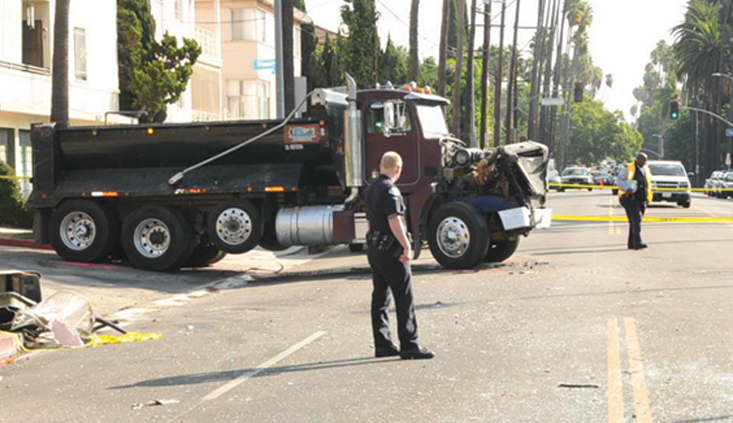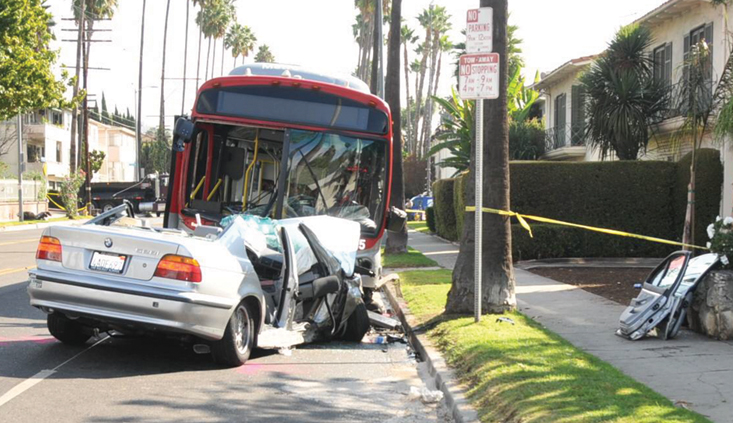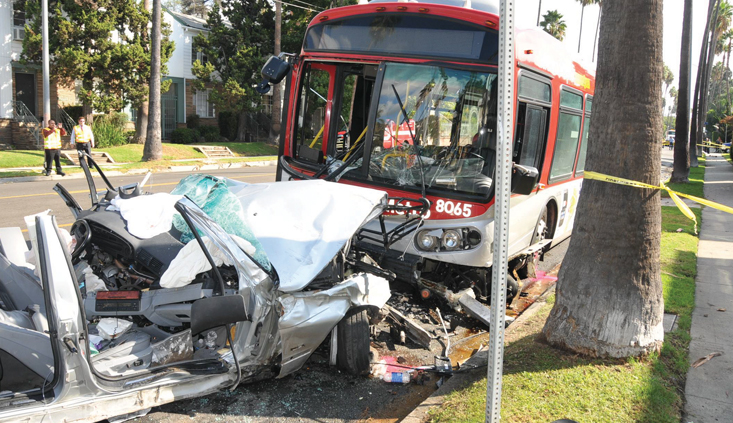The case of the runaway truck
How demonstrative evidence was used to build the case against the MTA when its bus was struck by a runaway truck
Presenting a meritorious plaintiff’s case is really an exercise in storytelling. Many trial lawyers believe the party with the best story to tell in a meaningful way will likely succeed at trial. I believe our clients’ stories are best told through demonstrative evidence, including videos, pictures, illustrations, animations, and timelines. Importantly, if you can use key demonstrative evidence to support your case theme/story at trial, you are likely to have success for your client.
Unfortunately, we can have great demonstrative evidence, but it is only useful if you can get it admitted into evidence and/or show it to the jury at trial. If you are going to use demonstrative evidence at trial, you must plan early and prepare the proper foundation for admissibility.
Additionally, with a few exceptions, you must share it with the other side before trial. Sharing the evidence with opposing counsel will give you the best chance of avoiding objections and/or motions to exclude the evidence.
Frequently, I am asked if we plaintiffs’ attorneys should provide the defense with client photos and videos before trial and during discovery. The answer is “yes” if you want to use this evidence at trial. Additionally, judges do not like to be surprised at trial with new photos, videos, etc. You can avoid a big headache and the possibility of exclusion by showing your demonstrative evidence to the defense well in advance of trial. Obviously, there might be an exception to this rule, i.e., for impeachment purposes, but if it is a close call, you are almost always better to share it with the other side.
Animations
I like to use animations in the right case to help an expert explain their opinions to the jury. The general rule is an animation can be used to illustrate the expert’s opinions but cannot be used to reenact the exact accident. (People v. Duenas (2012) 55 Cal.4th 1.)
Although the Duenas case was a criminal case, it is often cited to determine the standard to be applied for admissibility of animations when they are used to explore or demonstrate an expert’s opinion.
The court usually rules that computer animations are not substantive evidence to prove the facts of a case; rather, they are demonstrative evidence used to help a jury to “understand” substantive evidence. The key question you always want to ask your expert during direct examination is to establish the foundational testimony that the expert needs the animation to help explain their opinions to the jury.
This same analysis can be used in a variety of ways with medical diagnosis and animation to explain an injury or a surgical procedure.
Bus videos
Almost all city and county buses are now equipped with multiple camera board videos. These videos can be extremely valuable, and you must get these in discovery from the defense. Once you obtain the video, you should take a deposition or two of the people responsible for maintaining the video footage in order to lay the foundation for their admissibility, just in case the defense objects to this evidence.
Additionally, I like to take stills off the bus video footage shortly before impact at 10-second, five-second, three-second, and two-second intervals, and use these stills as exhibits to the bus driver’s deposition. This testimony can also be used to lay foundation with the bus driver, who will likely admit that the video is accurate, and that the still photos fairly and accurately depict the scene on the day and the time of the accident.
Some buses also have a GPS feature such as “SMARTDRIVE.” You need to request this evidence separately from the bus video. The “SMARTDRIVE” feature records speed, direction of travel, braking, and other elements usually 20 seconds or so before impact. The “SMARTDRIVE” information can be crucial to your case and provide valuable information about the bus driver’s actions in the seconds leading up to impact. This critical time element may help you to impeach or refresh the memory of a bus driver. Also, it might provide important detail for your accident reconstructionist and/or bus-driving expert.
Let me demonstrate how this works with a real-life case example.
Segal v. MTA
The Segal case involved a mother/wife, who was taking her daughter to middle school one morning on Hollywood Blvd. in Los Angeles. Unbeknownst to her, there was an overweighted dump truck parked at a residential job site that was uphill on a side street that intersected with Hollywood Blvd. The dump truck became a driverless runaway; it started to slide down the street, downhill towards Hollywood Blvd., at about 7:30 in the morning without anyone in the cab. As the dump truck picked up speed on the downhill slope, it came into traffic across Hollywood Blvd. At the same time, an MTA bus was coming up Hollywood Blvd., loaded with morning commuters on their way to work. The dump truck hit the MTA bus about midway behind the front passenger door. The bus then went across the center line and hit my client head on in her BMW at 38 miles per hour.
The impact was huge, causing massive injuries to the driver of the BMW and smaller injuries to her daughter, even though the airbags deployed. Additionally, over 20 people were injured on the bus. The LAPD arrived, secured the scene, including the dump truck, the city bus and my client’s BMW (that was almost underneath the front of the bus). My client had to be removed from her vehicle by the “Jaws of Life” with a broken neck and many severe injuries.
I obtained the traffic-collision report and noticed the LAPD took numerous photos at the scene. These were all ordered, as well as the local news footage from a helicopter that covered the scene. The traffic-collision report placed all the blame on the dump truck, which investigation revealed, had not had its tires properly chocked at the job site.
The traffic-collision report also checked the box that indicated the roadway conditions were “wet.” This notation seemed to be in contrast to the scene photos which reflected a typical sunny warm day in Los Angeles. This would prove to be important information later on!
Discovery brings bad news
Discovery commenced and, unfortunately, we learned that the dump-truck owner was a small father-and-son business with only $750,000 in liability insurance. It got worse. We found out from the truck manufacturer that the dump truck had been illegally modified by the owners to add an additional 10,000 pounds of weight without adding additional modification to the braking system to accommodate the extra weight.
Additionally, the parking brake was not strong enough to hold this truck in place on the downslope because of the after-market modifications. Therefore, any possible products case was precluded because of those modifications. We obtained the bus video in discovery and also found out the bus was equipped with “SMARTDRIVE.”
The bus video showed that the roadway was wet that morning and it even showed the window wipers were on at the time of impact.
We obtained the bus drivers’ training manual in discovery. The training manual had a section for the drivers when the roadway was wet. The bus drivers were required to slow down 8-10 miles per hour when it was raining and the roadway was wet. I went through the manual with the driver during her deposition and she admitted that she was taught this information.
Bus driver negligence
The “SMARTDRIVE” tape showed she was actually going 38 miles per hour in a 35 mile-per-hour zone at the time of impact. This was an important piece of the puzzle for our reconstruction expert. What if the bus driver had only been going 28 miles per hour shortly before the time of impact? What if the bus driver could have seen the truck a few seconds before the impact and “covered” her brake? How would these items have affected the perception reaction time and the dynamics of this accident?
One more key piece of evidence from both the drivers’ training manual and the “SMARTDRIVE” would change the whole dynamic of this case. The training manual expressly stated that a driver is not to swerve before braking when encountering a hazard.
Those of you who have grown up in a rural area or have driven on country roads learn this lesson at a young age when encountering a deer. You were taught to brake and hit the deer. You were taught not to swerve into oncoming traffic to avoid the deer.
This was the same instruction for the MTA bus drivers. At the deposition, I asked the bus driver if she braked first or swerved first. She testified she did not remember. When confronted with the “SMARTDRIVE” information, it was clear she swerved first before braking and before impact with my client’s car. If we did not have the “SMARTDRIVE”-generated directional graph, we would never have been able to prove she swerved first.
This crucial demonstrative evidence was now applied to both reconstruction and MTA bus driver practices. The reconstruction on P.C. crash (a computer program) revealed that if the bus driver had been going 28 miles per hour and covered her brake when the truck came into view on the video (more than two seconds before impact), she would have been able to apply her brakes and at worst had a small impact with the trailer or the truck.
More importantly, the computer simulation showed she would not have crossed the center line and hit my client head on!
This visual demonstrative evidence along with the MTA training manual changed this case from a policy limit of $750,000 that had to be shared with 20-some people on the bus, into a major seven-figure settlement that covered my client’s huge medical bills in the past and provided for needed medical care for her in the future.
In conclusion, when presenting your client’s story, you want to use as many videos, photographs, and other demonstrative evidence as possible to tell your client s story on both liability and damages.
Geoff Wells

Geoff Wells practices complex personal-injury law with Greene Broillet & Wheeler, LLP. Geoff is an elected member of the American Board of Trial Advocates. He also is a member of the Consumer Attorneys of California, American Association for Justice and an officer of the Consumer Attorneys Association of Los Angeles where he currently serves on their Board of Governors. Since 1995, Geoff has served as an arbitrator for the Superior Court for the County of Los Angeles. He is a frequent lecturer on trial preparation and practice in California. Other professional organizations that Geoff is a member of include the Los Angeles County and American Bar Associations, Santa Monica Bar Association and Eighth Street Trial Lawyers.
Copyright ©
2026
by the author.
For reprint permission, contact the publisher: Advocate Magazine



